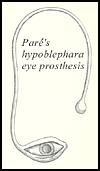 The eye was a symbol of life to the ancient world, particularly in Egypt, where bronze and precious stone eyes were placed on the deceased. The Romans decorated statues with artificial eyes made of silver. Ambrose Paré (1510-1590), a famous French surgeon, was the first to describe the use of artificial eyes to fit an eye socket. These pieces were made of gold and silver, and two types can be distinguished: ekblephara and hypoblephara, intended to be worn in front of or under the eyelids, respectively. A hypoblephara eye was designed to be used above an atrophic eye, as enucleation was not a common practice until the middle of the 1800s.
The eye was a symbol of life to the ancient world, particularly in Egypt, where bronze and precious stone eyes were placed on the deceased. The Romans decorated statues with artificial eyes made of silver. Ambrose Paré (1510-1590), a famous French surgeon, was the first to describe the use of artificial eyes to fit an eye socket. These pieces were made of gold and silver, and two types can be distinguished: ekblephara and hypoblephara, intended to be worn in front of or under the eyelids, respectively. A hypoblephara eye was designed to be used above an atrophic eye, as enucleation was not a common practice until the middle of the 1800s.
More here.